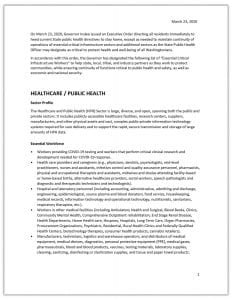Governor’s office offers an explanation of what businesses are essential and non-essential
VANCOUVER — On Monday (March 23), Washington Gov. Jay Inslee issued an Executive Order directing all residents “immediately to heed current state public health directives to stay home, except as needed to maintain continuity of operations of essential critical infrastructure sectors and additional sectors as the State Public Health Officer may designate as critical to protect health and well-being of all Washingtonians.’’

In accordance with this order, the governor has designated a list of “Essential Critical Infrastructure Workers” to help state, local, tribal, and industry partners as they work to protect communities, while ensuring continuity of functions critical to public health and safety, as well as economic and national security.
Clark County Today reached out to the governor’s office after Monday’s announcement to seek clarification as to the enforcement of the order.
“We are exploring what enforcement actions make the most sense without diverting too many public safety resources,’’ responded Mike Faulk, deputy communications director/press secretary for the Office of Governor Jay Inslee. “If a business willingly violates the order, it amounts to a gross misdemeanor. Additional enforcement actions, such as fines or revoking business licenses, are also being considered.’’
Faulk also confirmed that businesses can apply for an exception to the order
“There is no list of businesses that can apply for an exception,’’ Faulk said. “Any business can apply, but that is no guarantee they will be granted.’’
The Clark County Sheriff’s Office issued a response to the governor’s order Tuesday morning.
“Rumors of individuals or businesses needing ‘passes’ or ‘licenses’ to conduct essential services are not true,’’ read the statement from the CCSO. “Rumors of strict law enforcement or ‘martial law’ are not true.
“We understand some people need to carry out essential services,’’ the statement added.
Essential businesses
The governor’s office broke down the list of essential businesses into sectors. Here is a breakdown of those sectors with a brief explanation. For a broader definition, follow the link:
• HEALTHCARE/PUBLIC HEALTH: The Healthcare and Public Health (HPH) Sector is large, diverse, and open, spanning both the public and private sectors. It includes publicly accessible healthcare facilities, research centers, suppliers, manufacturers, and other physical assets and vast, complex public-private information technology systems required for care delivery and to support the rapid, secure transmission and storage of large amounts of HPH data.
• EMERGENCY SERVICES: The Emergency Services Sector (ESS) is a community of highly-skilled, trained personnel, along with the physical and cyber resources, that provide a wide range of prevention, preparedness, response, and recovery services during both day-to-day operations and incident response. The ESS includes geographically distributed facilities and equipment in both paid and volunteer capacities organized primarily at the federal, state, local, tribal, and territorial levels of government, such as city police departments and fire stations, county sheriff’s offices, Department of Defense police and fire departments, and town public works departments. The ESS also includes private sector resources, such as industrial fire departments, private security organizations, and private emergency medical services providers.
• FOOD AND AGRICULTURE: The Food and Agricultural (FA) Sector is composed of complex production, processing, and delivery systems and has the capacity to feed people and animals both within and beyond the boundaries of the United States. Beyond domestic food production, the FA Sector also imports many ingredients and finished products, leading to a complex web of growers, processors, suppliers, transporters, distributors, and consumers. This sector is critical to maintaining and securing our food supply.
• ENERGY: The Energy Sector consists of widely-diverse and geographically-dispersed critical assets and systems that are often interdependent of one another. This critical infrastructure is divided into three interrelated segments or sub sectors — electricity, oil, and natural gas — to include the production, refining, storage, and distribution of oil, gas, and electric power, except for hydroelectric and commercial nuclear power facilities and pipelines. The Energy Sector supplies fuels to the transportation industry, electricity to households and businesses, and other sources of energy that are integral to growth and production across the Nation. In turn, it depends on the Nation’s transportation, information technology, communications, finance, water, and government infrastructures.
• WATER AND WASTEWATER: The Water and Wastewater Sector is a complex sector composed of drinking water and wastewater infrastructure of varying sizes and ownership types. Multiple governing authorities pertaining to the Water and Wastewater Sector provide for public health, environmental protection, and security measures, among others.
• TRANSPORTATION AND LOGISTICS: The Transportation Systems Sector consists of seven key subsectors, or modes.
⁃ Aviation includes aircraft, air traffic control systems, and airports, heliports, and landing strips. Commercial aviation services at civil and joint-use military airports, heliports, and seaplane bases. In addition, the aviation mode includes commercial and recreational aircraft (manned and unmanned) and a wide-variety of support services, such as aircraft repair stations, fueling facilities, navigation aids, and flight schools.
⁃ Highway and Motor Carrier encompasses the roadway, bridges, and tunnels. Vehicles include trucks, including those carrying hazardous materials; other commercial vehicles, including commercial motor coaches and school buses; vehicle and driver licensing systems; taxis, transportation services including Transportation Network Companies, and delivery services including Delivery Network Companies; traffic management systems; AND cyber systems used for operational management.
⁃ The Maritime Transportation System consists of ferries, coastline, ports, pilotage, waterways, and intermodal landside connections that allow the various modes of transportation to move people and goods to, from, and on the water.
⁃ Mass Transit and Passenger Rail includes terminals, operational systems, and supporting infrastructure for passenger services by transit buses, trolleybuses, monorail, heavy rail — also known as subways or metros — light rail, passenger rail, and vanpool/rideshare.
⁃ Pipeline Systems consist of pipelines carrying natural gas hazardous liquids, as well as various chemicals. Above-ground assets, such as compressor stations and pumping stations, are also included.
⁃ Freight Rail consists of major carriers, smaller railroads, active railroad, freight cars, and locomotives.
⁃ Postal and Shipping includes large integrated carriers, regional and local courier services, mail services, mail management firms, and chartered and delivery services.
• COMMUNICATIONS AND INFORMATION TECHNOLOGY: The Communications Sector provides products and services that support the efficient operation of today’s global information-based society. Communication networks enable people around the world to contact one another, access information instantly, and communicate from remote areas. This involves creating a link between a sender (including voice signals) and one or more recipients using technology (e.g., a telephone system or the Internet) to transmit information from one location to another. Technologies are changing at a rapid pace, increasing the number of products, services, service providers, and communication options. The national communications architecture is a complex collection of networks that are owned and operated by individual service providers. Many of this
sector’s products and services are foundational or necessary for the operations and services provided by other critical infrastructure sectors. The nature of communication networks involve both physical infrastructure (buildings, switches, towers, antennas, etc.) and cyber infrastructure (routing and switching software, operational support systems, user applications, etc.), representing a holistic challenge to address the entire physical-cyber infrastructure. The IT Sector provides products and services that support the efficient operation of today’s global information-based society and are integral to the operations and services provided by other critical infrastructure Sectors. The IT Sector is comprised of small and medium businesses, as well as large multinational companies. Unlike many critical infrastructure Sectors composed of finite and easily identifiable physical assets, the IT Sector is a functions-based Sector that comprises not only physical assets but also virtual systems and networks that enable key capabilities and services in both the public and private sectors.
• OTHER COMMUNITY-BASED GOVERNMENT OPERATIONS AND ESSENTIAL FUNCTIONS
• CRITICAL MANUFACTURING: The Critical Manufacturing Sector identifies several industries to serve as the core of the sector: Primary Metals Manufacturing, Machinery Manufacturing, Electrical Equipment, Appliance, and Component Manufacturing, Transportation Equipment Manufacturing Products made by these manufacturing industries are essential to many other critical infrastructure sectors.
• HAZARDOUS MATERIALS
• FINANCIAL SERVICES: The Financial Services Sector includes thousands of depository institutions, providers of investment products, insurance companies, other credit and financing organizations, and the providers of the critical financial utilities and services that support these functions. Financial institutions vary widely in size and presence, ranging from some of the world’s largest global companies with thousands of employees and many billions of dollars in assets, to community banks and credit unions with a small number of employees serving individual communities. Whether an individual savings account, financial derivatives, credit extended to a large organization, or investments made to a foreign country, these products allow customers to: Deposit funds and make payments to other parties; Provide credit and liquidity to customers; Invest funds for both long and short periods; Transfer financial risks between customers.
• CHEMICAL: The Chemical Sector — composed of a complex, global supply chain — converts various raw materials into diverse products that are essential to modern life. Based on the end product produced, the sector can be divided into five main segments, each of which has distinct characteristics, growth dynamics, markets, new developments, and issues: Basic chemicals; Specialty chemicals; Agricultural chemicals; Pharmaceuticals; Consumer products
• DEFENSE INDUSTRIAL BASE: The Defense Industrial Base Sector is the worldwide industrial complex that enables research and development, as well as design, production, delivery, and maintenance of military weapons systems, subsystems, and components or parts, to meet U.S. military requirements. The Defense Industrial Base partnership consists of Department of Defense components, Defense Industrial Base companies and their subcontractors who perform under contract to the Department of Defense, companies providing incidental materials and services to the Department of Defense, and government-owned/contractor operated and government-owned/government-operated facilities. Defense Industrial Base companies include domestic and foreign entities, with production assets located in many countries. The sector provides products and services that are essential to mobilize, deploy, and sustain military operations.
For more information
To clarify or certify status, or to petition to be added to this list, please the Washington State Business Re-Entry Registration website at: https://mil.wa.gov/business-re-entry-registration





